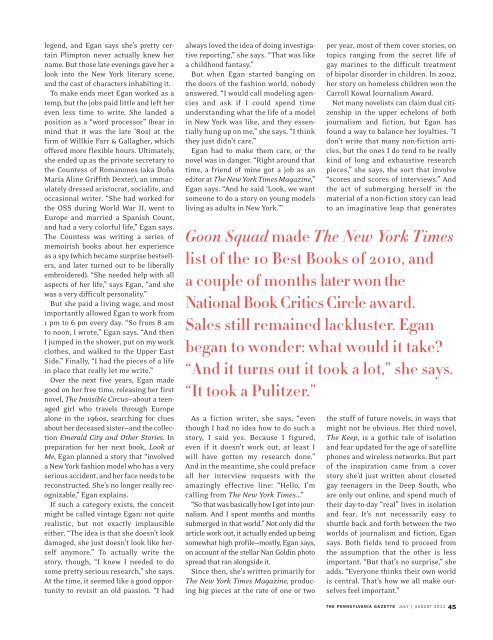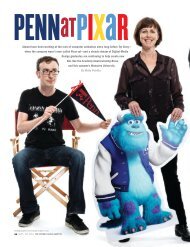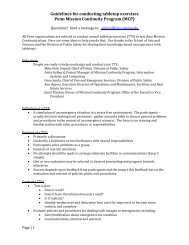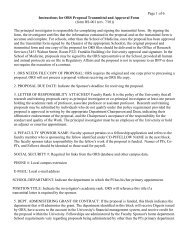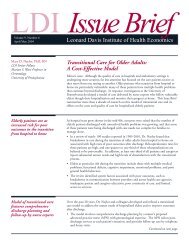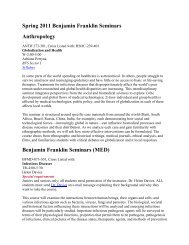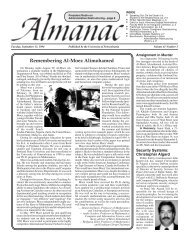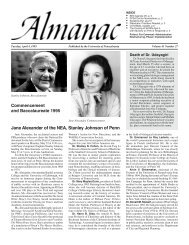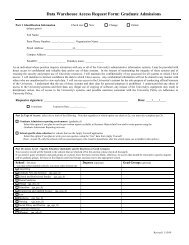legend, and Egan says she’s pretty certainPlimpton never actually knew hername. But those late evenings gave her alook into the New York literary scene,and the cast <strong>of</strong> characters inhabiting it.To make ends meet Egan worked as atemp, but the jobs paid little and left hereven less time to write. She landed aposition as a “word processor” (bear inmind that it was the late ’80s) at thefirm <strong>of</strong> Willkie Farr & Gallagher, which<strong>of</strong>fered more flexible hours. Ultimately,she ended up as the private secretary tothe Countess <strong>of</strong> Romanones (aka DoñaMaría Aline Griffith Dexter), an immaculatelydressed aristocrat, socialite, andoccasional writer. “She had worked forthe OSS during World War II, went toEurope and married a Spanish Count,and had a very colorful life,” Egan says.<strong>The</strong> Countess was writing a series <strong>of</strong>memoirish books about her experienceas a spy (which became surprise bestsellers,and later turned out to be liberallyembroidered). “She needed help with allaspects <strong>of</strong> her life,” says Egan, “and shewas a very difficult personality.”But she paid a living wage, and mostimportantly allowed Egan to work from1 pm to 6 pm every day. “So from 8 amto noon, I wrote,” Egan says. “And thenI jumped in the shower, put on my workclothes, and walked to the Upper EastSide.” Finally, “I had the pieces <strong>of</strong> a lifein place that really let me write.”Over the next five years, Egan madegood on her free time, releasing her firstnovel, <strong>The</strong> Invisible Circus—about a teenagedgirl who travels through Europealone in the 1960s, searching for cluesabout her deceased sister—and the collectionEmerald City and Other Stories. Inpreparation for her next book, Look atMe, Egan planned a story that “involveda New York fashion model who has a veryserious accident, and her face needs to bereconstructed. She’s no longer really recognizable,”Egan explains.If such a category exists, the conceitmight be called vintage Egan: not quiterealistic, but not exactly implausibleeither. “<strong>The</strong> idea is that she doesn’t lookdamaged, she just doesn’t look like herselfanymore.” To actually write thestory, though, “I knew I needed to dosome pretty serious research,” she says.At the time, it seemed like a good opportunityto revisit an old passion. “I hadalways loved the idea <strong>of</strong> doing investigativereporting,” she says. “That was likea childhood fantasy.”But when Egan started banging onthe doors <strong>of</strong> the fashion world, nobodyanswered. “I would call modeling agenciesand ask if I could spend timeunderstanding what the life <strong>of</strong> a modelin New York was like, and they essentiallyhung up on me,” she says. “I thinkthey just didn’t care.”Egan had to make them care, or thenovel was in danger. “Right around thattime, a friend <strong>of</strong> mine got a job as aneditor at <strong>The</strong> New York Times Magazine,”Egan says. “And he said ‘Look, we wantsomeone to do a story on young modelsliving as adults in New York.’”per year, most <strong>of</strong> them cover stories, ontopics ranging from the secret life <strong>of</strong>gay marines to the difficult treatment<strong>of</strong> bipolar disorder in children. In 2002,her story on homeless children won theCarroll Kowal Journalism Award.Not many novelists can claim dual citizenshipin the upper echelons <strong>of</strong> bothjournalism and fiction, but Egan hasfound a way to balance her loyalties. “Idon’t write that many non-fiction articles,but the ones I do tend to be reallykind <strong>of</strong> long and exhaustive researchpieces,” she says, the sort that involve“scores and scores <strong>of</strong> interviews.” Andthe act <strong>of</strong> submerging herself in thematerial <strong>of</strong> a non-fiction story can leadto an imaginative leap that generatesGoon Squad made <strong>The</strong> New York Timeslist <strong>of</strong> the 10 Best Books <strong>of</strong> 2010, anda couple <strong>of</strong> months later won theNational Book Critics Circle award.Sales still remained lackluster. Eganbegan to wonder: what would it take?“And it turns out it took a lot,” she says.“It took a Pulitzer.”As a fiction writer, she says, “eventhough I had no idea how to do such astory, I said yes. Because I figured,even if it doesn’t work out, at least Iwill have gotten my research done.”And in the meantime, she could prefaceall her interview requests with theamazingly effective line: “Hello, I’mcalling from <strong>The</strong> New York Times…”“So that was basically how I got into journalism.And I spent months and monthssubmerged in that world.” Not only did thearticle work out, it actually ended up beingsomewhat high pr<strong>of</strong>ile—mostly, Egan says,on account <strong>of</strong> the stellar Nan Goldin photospread that ran alongside it.Since then, she’s written primarily for<strong>The</strong> New York Times Magazine, producingbig pieces at the rate <strong>of</strong> one or twothe stuff <strong>of</strong> future novels, in ways thatmight not be obvious. Her third novel,<strong>The</strong> Keep, is a gothic tale <strong>of</strong> isolationand fear updated for the age <strong>of</strong> satellitephones and wireless networks. But part<strong>of</strong> the inspiration came from a coverstory she’d just written about closetedgay teenagers in the Deep South, whoare only out online, and spend much <strong>of</strong>their day-to-day “real” lives in isolationand fear. It’s not necessarily easy toshuttle back and forth between the twoworlds <strong>of</strong> journalism and fiction, Egansays. Both fields tend to proceed fromthe assumption that the other is lessimportant. “But that’s no surprise,” sheadds. “Everyone thinks their own worldis central. That’s how we all make ourselvesfeel important.”THE PENNSYLVANIA GAZETTE JULY | AUGUST 2011 45
long as it needs to go on,” she says.As her c<strong>of</strong>fee cools, I ask Egan the she says, while trying to make photocopies46 JULY | AUGUST 2011 THE PENNSYLVANIA GAZETTEquestion that one is obliged to ask someonewho’s just won the Pulitzer: What’sit like to win the Pulitzer? She laughs,and for the first time looks like shemight rather be somewhere else.“<strong>The</strong> biggest difference,” she says, “is youget asked that question a lot.” And justbeing asked constantly “gives you thefeeling that more should have changed.”One concrete effect is that sales <strong>of</strong> AVisit from the Goon Squad have finallystarted to pick up. Despite all the positivepress, when the book came out a year agoit threatened to sink without leavingmuch <strong>of</strong> a trace in the market. “It’s sucha killer,” Egan says, <strong>of</strong> the feeling sheexperienced then: that years <strong>of</strong> workmight be left to languish on the shelf,that the reading public simply wasn’t allthat interested. When things were lookinggrim, she remembers agreeing to goto a signing at a Borders, even thoughher publicist had informed her that thestore only had five copies. “Not a veryexciting quantity, but I was willing to gosign anything,” she says. “And when I gotthere, they still had five books. In fivedays, they hadn’t sold a single book.”<strong>The</strong> good reviews kept appearing, but thesigns were unmistakable. “You can just feelwhether a book is selling,” she says. GoonSquad made <strong>The</strong> New York Times list <strong>of</strong> the10 Best Books <strong>of</strong> 2010, and a couple <strong>of</strong>months later won the National Book CriticsCircle award. Sales still remained lackluster.Egan began to wonder: what would ittake? “And it turns out it took a lot,” shesays. “It took a Pulitzer.”in the basement <strong>of</strong> College Hall). A soon-tobestolen wallet is one <strong>of</strong> the first imagesthat appears in Goon Squad, and that’s thestory that she’s chosen for today. When shereads, her voice is cool and even:It began in the usual way, in the bathroom<strong>of</strong> the Lassimo Hotel. Sasha wasadjusting her yellow eye shadow in themirror when she noticed a bag on thefloor beside the sink that must havebelonged to the woman whose peeingshe could faintly hear through thevaultlike door <strong>of</strong> a toilet stall. Inside therim <strong>of</strong> the bag, barely visible, was a walletmade <strong>of</strong> pale green leather. It waseasy for Sasha to realize, looking back,that the peeing woman’s blind trusthad provoked her.Egan’s creative process <strong>of</strong>ten provokesconversation, because she’s known for writingall her fiction longhand, on legal pads.“<strong>The</strong>n the initial scrawl gets typed into acomputer,” she says, essentially turningher PC into an elaborate typewriter. “I’vewritten whole drafts <strong>of</strong> novels on legal padsand then typed that in,” she says.After it’s typed in, “I read what I’ve got,”and it’s not always pretty. “In the case <strong>of</strong>a long book, it’s painful to read hundreds<strong>of</strong> pages <strong>of</strong> that impetuous scrawl, suddenlyin typeface.” Her system might notsound particularly efficient, but it’s theonly way she’s found to access the imaginativespace that makes her fiction writingpossible at all.Once she’s read over her draft, sheforms an after-the-fact outline that willAfter she describes the mindset shetries to write from, I suggest it soundssomething like the approach behindmethod acting. Egan wrinkles her nose.(Her husband, David Herskovits, directsthe experimental Target Margin <strong>The</strong>aterin Brooklyn.) “Method acting has a reputation<strong>of</strong> being a little precious,” shesays. But she’s willing to entertain theparallel, in a limited sense. When she’sdoing her best work, she says, “I forgetwho I am, almost. And I find that notscary at all. I find that a pleasure.”In the tactile act <strong>of</strong> writing, she says,she can switch <strong>of</strong>f the mental chorus <strong>of</strong>judgment and distraction, whether it’sabout the household chores: “You have toget the laundry done.” Or about her ownwords: “That’s not very good. Why wouldanyone want to read that?” Or about hercharacters: “Why is he doing that?”Her more intuitive approach isn’t basedon unraveling the motivations <strong>of</strong> any particularcharacter, or solving plot problemsas though they’re equations. Rather, “I’mtrying to let a certain voice emerge, for thewhole work. <strong>The</strong> storytelling voice is themost important thing, to me,” she says.“<strong>The</strong> voice, and the texture <strong>of</strong> that voice.”Perhaps for this reason her work is strikinglynon-autobiographical, and Egan saysshe’s never transplanted a whole person oran experience into her work. It’s true thatfor Goon Squad, she drew on some <strong>of</strong> herown memories to recreate the feel <strong>of</strong> the’70s punk scene in San Francisco. “I wentto the Mabuhay Gardens, and went to lots<strong>of</strong> punk concerts there,” she says. “But itjust felt like a colorful environment that ITOher reading at the Kelly guide her revisions. “I sit down and try had access to.”Writers House, Egan wears in a very systematic way to figure out When Egan talks this way about thea green dress with a faintly what I’ve got, what it seems like it stray details <strong>of</strong> her life that have slippedcellular pattern, in a color that matchesthe bright stems <strong>of</strong> the fresh-cut tulipsperched on the old, wooden podium. <strong>The</strong>front room has overflowed, and a secondmonitor and temporary chairs arebeing hurriedly assembled. Egan’s owncopy <strong>of</strong> A Visit from the Goon Squad is abattered hardback missing its dust jacket,the pages marked with dozens <strong>of</strong>purple PostIt notes that have crumpleddown to the texture <strong>of</strong> old money.Earlier, she’d told me about her experiencebeing robbed as a student at Penn(“Actually, this is unbelievable, I was robbedon consecutive weeks, in the same place,”should be, and what it wants to be,” shesays. <strong>The</strong> outline itself can stretch tothe length <strong>of</strong> a novella (for her longestbook, Look at Me, the first outline filled80 pages). “It has checklists,” she says,“and I literally check them <strong>of</strong>f.”She prints out a hard copy and, armedwith her outline, goes back to rewritingand editing directly on the printouts,again working longhand so that shecan reenter the mindset she needs tocreate new material. <strong>The</strong> marked updrafts are typed back in, and the processcontinues. “It’s a dialectic betweenanalysis and impulse. And it goes on asinto her work, it sounds as impersonal asan empty movie set. Slowly, she will populateit with the characters that takeshape on her legal pad, in her own messyhandwriting, as she excavates her imaginationwith all the care <strong>of</strong> a good archeologistsifting through the accumulatedlayers <strong>of</strong> history and memory.“My entry point is a time and place,”she says, “and it’s best not to know toomuch more than that. Because the surprisesare always the best.” ◆Sean Whiteman LPS’11 is a recent Penn graduateand frequent Gazette contributor. He lives inSan Francisco.


